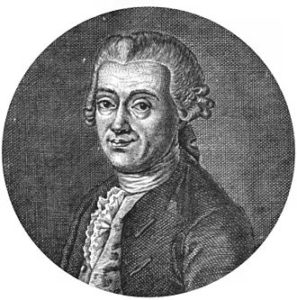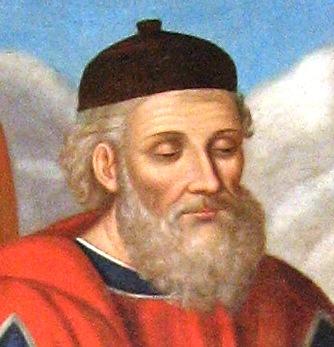Ceres
Bode’s Law
Bode’s Law or more correctly Titius-Bode’s Law is named after two German astronomers, Johann Daniel Titius and
Johann Elert Bode, proposed in the 18th century that there was a mathematical relationship between the then six known planets and their distance from the sun, with each one roughly twice the distance as the previous planet. Although the idea was conceived by Titius, it was Bode who gave it greater prominence, when he used it to predict the existence of Uranus and later Ceres in the Asteroid Belt. At that point, it was accepted as a ‘law’.
In the 19th century, Urbain LeVerrier and John Couch Adams working independently, used the Titius-Bode model combined with calculations based on Newton’s Law of Gravity to predict where the next planet, Neptune, should be found. Kamienski wrote a short paper comparing the formulae of LeVerrier & Adams with that of Titius-Bode(m).
The subject has been debated throughout the 20th century. I.J. Good, a British mathematician who worked with Alan Turing during WWII at Bletchley Park, offered a paper in support of Titius-Bode in 1968(b). Bradley Efron, an American statistician, proposed an opposing view(c). Both papers are best suited to the mathematically advanced.
The late Timo Niroma has offered some interesting observations(j) on the mechanics behind Titius-Bode and developed a cosmology based upon atomic weights, noting that “What happens on a small scale seems to obey the same laws on a much grander scale.”
Georgi Gladyshev, a Russian scientist, has proposed an explanation for Titius-Bode based on the work of Raphael Liesegang(g) who proposed the concept of ‘periodic precipitation’. Gladyshev applied Liesegang’s theory to the early stages of the formation of our Solar System(h)(i)(t)*. It was hoped that this may bring us closer to the physics behind the distribution of the planets!
It has also been proposed that a Titius-Bode-Type ‘rule’ seems to be applicable to planetary satellite systems(d), particularly that of Uranus(p), and there appears to be evidence(a) that Titius-Bode is also applicable to exoplanetary systems!
The Titius-Bode Law has also been linked with the Fibonacci Series(e) as well as the Golden Mean(f).
Velikovskian catastrophism proposes[0037.152] that Atlantis was destroyed as a result of the periodic close encounters of our planet and Moon with Venus and/or Mars during the 1st & 2nd millennia BC. According to Velikovsky, Venus was a relatively recent newcomer to the Solar System and the orbit of Mars had been disturbed, which would suggest that prior to the arrival of Venus and the displacement of Mars, Bode’s Law would have been invalidated! C.J. Ransom has tackled this head-on in The Age of Velikovsky [1880.90]. However, his defence of Bode and Velikovsky was rejected by Dr M. M. Nieto(n).
Louis Jacot (1906- ) was a Swiss economist and jurist who added the study of science and philosophy to his intellectual toolkit. He developed some novel cosmological theories, including enthusiastic support for Bode’s Law which he described as “the great key to the mysteries of the Universe.” [1774] While this may be overstating his case, I cannot help feeling that Bode’s Law is an expression of cosmological principles operating in a manner not as yet identified! At its simplest, the question is, are we to believe that the spacing of the planets came about purely by chance or is there an unrecognised force or forces at play?
For my own part, I have always felt that Bode’s Law was a highly convincing concept, but unfortunately, I do not have the mathematical or astronomical ability required to objectively verify its reality, nor the proposed Fibonacci Sequence and the Golden Mean relationship with it. It would appear that acceptance of Bode would create difficulties not just for the Saturn Theory but also for Velikovsky’s idea that Venus was just a large piece of ejecta from Jupiter that had catastrophic close encounters with Earth and Mars, within human experience, just a few thousand years ago. Such an idea would mean that prior to the Saturnian rearrangement of the planets or the Velikovskian creation of Venus, the positional relationship of the planets probably did not conform to any known mathematical model but after this/these calamitous events everything ‘coincidentally’ settled into orbits that are now claimed to conform to Bode, Fibonacci and the Golden Mean! Can we believe that after careening around the solar system including a number of close encounters with Earth, that all the planets adopted new orbits that conformed closely with Bode’s Law? Surely, this is a coincidence too far?
Stephen M. Phillips has published a lengthy paper entitled ‘The Logarithmic Spiral Basis of the Titius-Bode Law’. For me this document is difficult to absorb, involving as it does Musical theory, Pythagoras, String Theory and plenty of mathematics (q).
Although the ‘Law’ has been generally abandoned by mainstream scientists, there is still interest in some quarters. One of those was the British astronomer, the late Michael Ovenden (1926-1987) who produced a modified version of the original formula(k). Another version involves an interpretation of quantum mechanics, called pilot-wave theory(l)!
W.I. Newman, M.P. Haynes, and Y. Terzian “have considered the psychological tendency to find a pattern where none exists, and have also discussed how inappropriate inferences regarding astronomical phenomena have been drawn from statistical analyses.” (o)
In May 2023, the Live Science website(r) wrote that “Earth probably shouldn’t exist – that’s because the orbits of the inner solar system planets — Mercury, Venus, Earth and Mars — are chaotic, and models have suggested that these inner planets should have crashed into each other by now. And yet, that hasn’t happened.”
Jacques Laskar, astronomer and research director at the National Center for Scientific Research and Paris Observatory is a co-author of the new study(s). in which he and his colleagues have identified for the first time ‘symmetries’ or ‘conserved quantities’ in the gravitational interactions that create a “practical barrier in the chaotic wandering of the planets,” Where previously they had calculated that there was a 1% possibility of collision among the inner planets over 5 billion years. However, the introduction of these new ‘symmetries’ suggested that it could take 30 billion years for any planets to collide.
I can’t help wondering if Bode’s Law might be an expression of these symmetries.
>Nearly a decade ago Doug Yurchey (writing as Tray Caladan) published a paper(u) in support of Bode’s Law. He brought Pluto back into the family of Solar System planets and suggested that more may be added – “Is Sedna the furthest extent of our planetary system? Doubtful. We may have to carry Bode’s Law out one, two or even three more places (distances) to arrive at the actual composition of our Solar System.”<
Also See: Saturn Theory
(a) https://arxiv.org/abs/1602.02877
(d) Titius-Bode-Type Rules for Planetary Satellite Systems (archive.org)
(f) https://www.fq.math.ca/Scanned/22-1/lombardi.pdf
(g) https://www.insilico.hu/liesegang/history/history.html
(h) As Above So Below – Georgi Gladyshev | MalagaBay (archive.org)
(i) https://file.scirp.org/pdf/NS_2015051816303613.pdf
(j) As Above So Below – Timo Niroma | MalagaBay (archive.org)
(k) https://www.researchgate.net/scientific-contributions/2021145656_Michael_W_Ovenden
(m) Atlantis, Volume 13, No.1 December 1959
(n) The Titius-Bode Law (archive.org)
(o) Redshift Data and Statistical Inference, Astrophys. J., 431, 147, 1994.
(p) https://old.world-mysteries.com/sci_8.htm 2/3rds of the way down
(q) http://www.smphillips.mysite.com/article-17.html
(r) Scientists discover secret ‘symmetries’ that protect Earth from the chaos of space | Live Science
(s) XY10707_min.pdf (pardot.com)
(t) (99+) The solar system evolution | Georgi Gladyshev – Academia.edu *
Diodorus Siculus
Diodorus Siculus (c. 90-21 BC) was born in Agyrium, Sicily. He travelled extensively through Europe and Asia gathering information that was to be incorporated in his Bibliotheca Historica, a work of forty books divided into three parts. Unfortunately, only the first five books are extant(a). He quotes extensively from an earlier historian Skytobrachion. Nevertheless in this remnant of his work we find Diodorus making a number of references to Atlantis.
He calls the land bordered by the Atlantic and surrounded by the Atlas Mountains, ‘Atlantis’, which would be modern Morocco. Diodorus tells how a great king there, renowned as an astrologer, called Atlas, named the whole region and the sea after himself. Diodorus writes that following the death of the Titan, Hyperion, the world was divided among the sons of Uranus. Accordingly, Cronus and Atlas were given the regions on the coast of Oceanus (Atlantic). A mountain was called after Atlas and the local inhabitants named Atlantioi.
What is strange here is that according to Greek myth, Atlas is noted as the son of Iapetus, yet Plato has Atlas as the son of Poseidon. This divergence between Diodorus and Plato would seem to indicate that Diodorus was NOT depending on Plato for details of his Atlantis story. Plato did not refer to an astrologer and gives a different lineage for Atlas.
Diodorus claims that the people of Atlantis had no knowledge of the fruits of Ceres the Roman goddess of plant growth. This appears to suggest that the Atlanteans did not have cereals and consequently no bread or brewing! It may be worth noting that American Indians also lacked any knowledge of cereals.
He also writes about the Amazons, a warlike tribe ruled by women, from North Africa, where they lived on an island in ancient Lake Tritonis. He relates how this lake disappeared when earthquakes created a breach to the Mediterranean. This latter point may have particular relevance to atlantologists who identify the Tunisian coastal region as the location of Atlantis.
Diodorus gives details of a war fought by the Amazons against the Atlantioi, which they won. He also relates how the Phoenicians discovered in the Atlantic, an island of great wealth and beauty (Book V) and that this island was found by accident when they were carried by the Atlantic currents to its shores. This could not have been Atlantis as the island was discovered long after it was supposed to have been submerged, leaving just shoals of mud.
Bonev, Nikolay
Professor Nikolay Bonev (1898-1979) formerly held the chair of Astronomy at the University of Sofia, in Bulgaria, favoured an Atlantic location for Atlantis and published a number of papers[187][188][189] in the mid-20th century on the subject. He was inclined to the idea of an asteroid strike or close fly-by as the  primary cause of the destruction of Atlantis(b). He considered that an asteroid approaching the earth would have caused a tide of enormous magnitude that would have created incredible devastation as it either followed its course as the asteroid either flew past or reacted to a massive sea impact. Bonev specifically favoured the asteroid Ceres as the culprit.
primary cause of the destruction of Atlantis(b). He considered that an asteroid approaching the earth would have caused a tide of enormous magnitude that would have created incredible devastation as it either followed its course as the asteroid either flew past or reacted to a massive sea impact. Bonev specifically favoured the asteroid Ceres as the culprit.
Bonev, caused a stir in 1961 when he expressed the view that our Moon had once been an independent planet(a) that had experienced violent volcanic eruptions that were powerful enough to have produced a ‘recoil’ effect, which nudged it towards our Earth’s orbit and was eventually captured as our satellite. His views had echoes of Hans Hoerbiger’s discredited captured moons theory. At the time scientists rejected Bonev’s claim as unsubstantiated by evidence, but since then we have discover the ongoing mega-eruptions on Jupiter’s moon, Io, which is slightly larger than our Moon. No effect on Io’s orbit has been recorded.
*(b) https://www.oocities.org/motorcity/factory/2583/tidetheory.htm (link broken Oct. 2019)
See: Archive 2659*



